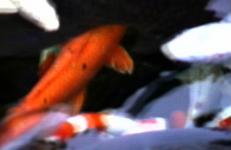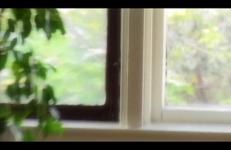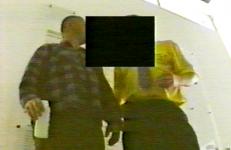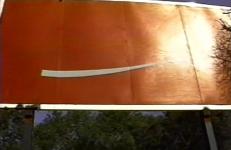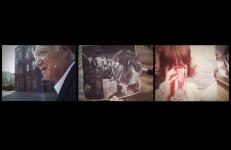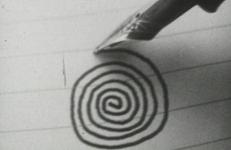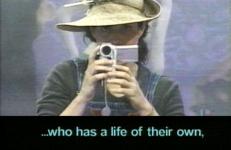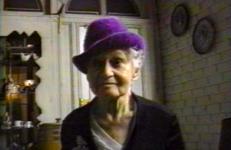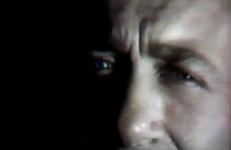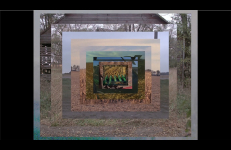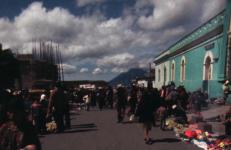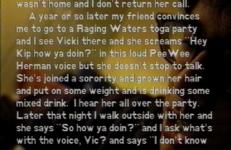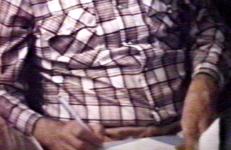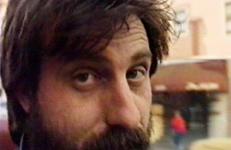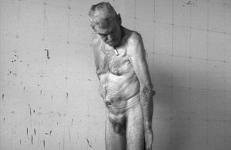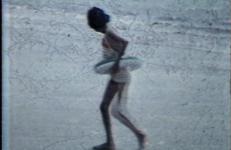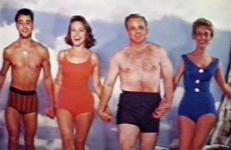Ever listen to Loveline? Well, here's an episode with a 24-year-old Korean American guy who's never been kissed. They're offering free concert tickets to any girl who'll come in and take a chance. The girls get their tickets, and "David" gets to pick one of them for his first smack. Trouble is... no volunteers. Combining personal dating stories and the hypnotic imagery of multi-colored koi, Sweet Or Spicy? explores Hapa and Asian American male sexuality in popular culture.
Autobiography
Recently I found myself rising from a forced landing on the floor after being catapulted into the air by an exercise machine and bouncing off the dresser. Through raccoon eyes, the effect of falling on my face, I squinted into the fog-filled room of my present, stumbling about apprehensively, my long-term memory scrambled and short-term memory severely inhibited. My once reliable body and memory were teetering on the brink of self-betrayal.
Divino explains how he got introduced to video. “Filming is my profession; that’s what I was born to do... not for the work with the axe. I wasn’t born to plant. I already said this to my wife.” Today, Divino dominates the language of video and its filming and editing techniques. He also talks about working in partnership with his community.
Directed by Divino Tserewahu; edited by Tutu Nunes.
In Portuguese with English subtitles.
Work, film, work, film, work – day to day – week to week. This is a home movie domestic comedy experimental film drama. Autobiography too. It’s also part four of an ever-growing trilogy.
Filmmaker Cam Archer examines and explores his ordinary, suburban neighborhood in search of hidden truths, new narratives and a better understanding of his fading, creative self. Combining heavily degraded video with personal photographs and real life neighbors, Archer re-imagines the concept of 'home video'. In an attempt to distance himself from his subjects, actress Jena Malone narrates the piece as Archer in the first person.
A tour of acting gigs that come my way and the people behind the cameras that aim at my expanding torso. A bloated ham in action on the West Coast and the thespians that rub shoulders with his hind quarters. Shot in San Francisco and Hollywood, USA.
A personal essay about connection and disconnection, in and through different realities.
This Is Not Beirut is a personal project that examines the use and production of images and representations of Lebanon and Beirut, both in the West and in Lebanon itself. It also records Salloum’s interactions and experiences while working in Lebanon, focusing on this representational process by a Westernized, foreign-born Lebanese mediator with cultural connections to and baggage from both the West and Lebanon.
This Was Home is comprised of three channels, which present three generations of the artist’s family. On one screen Levy presents her maternal grandfather, Karl Ribstein, another shows her father, Yossi Levy, and the third presents the artist herself. Levy documented each of these protagonists on a journey back to their childhood city and to the home where they grew up, which they had not revisited since having to leave it in their childhood.
Using a Super-8 camera, Henricks employs time-lapse photography to document the interior and exterior of his apartment. Inspired by the work of Virginia Woolf, Time Passes uses writing as a metaphor for notions of temporality and impermanence.
This title is also available on Nelson Henricks Videoworks: Volume 2.
“Take back the airwaves: Mexico’s video art doyenne Ximena Cuevas books herself onto the tabloid talk show Tombola (Raffle), toying at first with whimsical deconstruction until she turns the whole affair on its head by seizing the televisual flow itself.”
A series of intimate video-8 vignettes depicting the fierce love between Malverna and Sandi, 88 and 22, grandmother and grandson. The two playmates dress up drag-esque for this moving portrait of a woman’s lifetime struggle with gender and sexuality. Since Malverna's death, Tomboychik has become a living memorial to the intensity of her spirit.
TREYF “unkosher” in Yiddish— is an unorthodox documentary by and about two Jewish lesbians who met and fell in love at a Passover “seder”. With personal narration, real and imagined educational films, and haunting imagery, filmmakers Alisa Lebow and Cynthia Madansky examine the Jewish identity of their upbringings and its impact on their lives.
TREYF “unkosher” in Yiddish— is an unorthodox documentary by and about two Jewish lesbians who met and fell in love at a Passover “seder”. With personal narration, real and imagined educational films, and haunting imagery, filmmakers Alisa Lebow and Cynthia Madansky examine the Jewish identity of their upbringings and its impact on their lives.
Acconci again confronts both the viewer’s and his own expectations of his performance, saying, "I've waited for the perfect time, for the perfect piece, I'm tired of waiting... but no, you want me to have something ready for you, something prepared." Acconci addresses the artist's perpetual wait for both inspiration and appreciation. He pulls apart the relationship of the artist to the audience, which for Acconci constitutes a mixture of independence and co-dependence, relying on the viewer to both validate and motivate his work.
A hug/punch eulogy for all things impossible now. Vague Images is a sketch book of images and sounds from the year wrapped around a trip out to Loomis, South Dakota to find the abandoned farm where my grandfather grew up. At the same time the film is a travelogue of my frustrations and understandings of gay sexuality. The two are connected.
A cross-generational binding of three filmmakers seeking alternative possibilities to the power structures they are inherently part of. Each woman extends her reach to a subject she is outside of. Vever grew out of the abandoned film projects of Maya Deren and Barbara Hammer. Shot at the furthest point of a motorcycle trip Hammer took to Guatemala in 1975, and laced through with Deren’s reflections of failure, encounter and initiation in 1950s Haiti.
A vever is a symbolic drawing used in Haitian Voodoo to invoke Loa, or god.
This title is only available on Kip Fulbeck Selected Videos: Volume Two.
A very chatty array of people along with still photos and a loose-tongued cab driver, make this a leisurely stroll through my social life of several years ago.
The viewer meets a grab-bag of gabby folks from here and abroad as I drop by to see them or they come to my apartment for tea and sympathy. You also get to visit endangered film showcases and see people who are now either deceased or divorced.
The comings and goings of the late underground filmmaker, Curt McDowell—and the people and activities that came and went along with him—are the themes that run through this existential diary of daily life. McDowell was dying from AIDS-related illnesses during the production of the diary.
“An elegy for McDowell, the videowork captures Kuchar’s mournful remembrances of his long-lasting friendship with the young filmmaker. But it also has the inquisitive charm, perverse humor, and quirky candor that places Kuchar’s visual expressions in a gritty niche all their own.”
Voice: off is the autobiography of a forgotten man. Brain damaged, body violated, emotions crushed, Gerry who rarely spoke has now lost the power of speech. The video camera is his prosthesis and he borrows the memories of people who no longer need them. How can this be a comedy? It is. "Donigan Cumming looks at the violence of time that damages the body and exhausts memories. For the main character in Voice: off, Gerald, the illness is incurable. Two cancers are at work, one of which is attacking his throat.
In the fall of 1986, Richard Fung made his first visit to his father’s birthplace, a village in southern Guangdong, China. This experimental documentary examines the way children of immigrants relate to the land of their parents, and focuses on the ongoing subjective construction of history and memory. The Way to My Father's Village juxtaposes the son’s search for his own historical roots, and his father’s avoidance of his cultural heritage.
On a back-to-nature trip to Boulder, Colorado, George goes to the mountains, but goes on the rocks emotionally.
This title is also available on The World of George Kuchar.
“The tape ultimately addresses all the big questions — death, origin and family, religion — as well as the small discomforts of the body, only to reverse their order of importance.”
— Margaret Morse, Framework (Los Angeles Contemporary Exhibitions)




